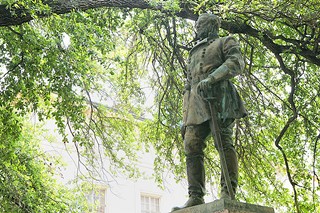Confederate Statue Report Released
UT task force recommends taking action
By Mac McCann, 10:53AM, Mon. Aug. 10, 2015
Since the Thirties, Confederate statues have looked over the South Mall at the University of Texas at Austin. Since at least the Sixties, the statues have been denounced as racist. Since the late Eighties, the statues have been protested and vandalized. Since the early Aughts, UT presidents have punted on the issue.
But now, in 2015, it appears something will finally be done. Today, Monday, Aug. 10, the 12-person Task Force on Historical Representation of Statuary at UT Austin submitted their report “identifying and evaluating options for addressing the controversial statues” to new UT President Gregory L. Fenves, who formed the task force in June.
Fenves will decide what exactly to do about the statues sometime before the end of the summer.
The task force’s report summarizes and evaluates five options for addressing the statues:
1) Leave the statues in place and add explanatory plaques.
2) Relocate the statue of Jefferson Davis, and the inscription to the west of the Littlefield Fountain, to the Briscoe Center for American History, the Blanton Museum, the Texas Memorial Museum, the Harry Ransom Center, the Littlefield home, or an exhibit elsewhere on campus.
3) Relocate the statues of Davis, Robert E. Lee, Albert Sidney Johnston, and John Reagan, and the inscription west of the Littlefield Fountain, to the Briscoe Center for American History, the Blanton Museum, the Texas Memorial Museum, the Harry Ransom Center, the Littlefield home, or an exhibit elsewhere on campus.
4) Relocate statues of Davis, Lee, Johnston, and Woodrow Wilson, and the inscription to the west of the Littlefield Fountain, to the Briscoe Center for American History, the Blanton Museum, the Texas Memorial Museum, the Harry Ransom Center, the Littlefield home, or an exhibit elsewhere on campus.
5) Relocate all six statues, including that of James Stephen Hogg, and the inscription to the west of the Littlefield Fountain, to the Briscoe Center for American History, the Blanton Museum, the Texas Memorial Museum, the Harry Ransom Center, the Littlefield home or an exhibit elsewhere on campus.
Notably, there is no option to leave the statues unaddressed, as both previous UT presidents, Faulkner and Powers (both of whom formed similar task forces), left them.
The task force looked into a wide variety of options, but only a few were deemed viable. The task force, which included students, faculty members, staff members, and alumni of the university, met six times. As the Chronicle reported, they hosted two public forums to gather input from the community, and heard from more than 3,100 individuals via an online submission form, emails, and phone calls. The report notes that, of the feedback, “33% were in favor of relocating the statue of Jefferson, 27% were in favor of removing all statues from the mall, while 33% were in favor of leaving them in their current locations, and approximately 7% suggested other options or provided other comments.”
PROS AND CONS OF EACH OPTION
The first option, which would be the simplest and least expensive, would leave the statues in place and add explanatory plaques. Adding the plaques would acknowledge that the university is aware of the controversy “while allowing the institution to put philosophical distance between UT Austin and honorees.” However, the report notes that “a significant portion of the campus community views the statues’ presence and placement as deeply offensive and unrepresentative of the university’s mission and values,” so leaving the statues in place would not end the controversy, and the statues “attract a nuisance in form of vandalism,” which preventing and cleaning up comes at a cost. The report also notes that this option “could be perceived as passive, lacking leadership.”
For the other four options, some or all of the statues would be relocated to somewhere else on campus, which would allow the statues to remain in the university’s possession. While multiple locations are possibilities, “The majority of the task force believes the Dolph Briscoe Center for American History, which has offered to take custody of the statues, presents the most natural solution for relocation,” according to the report. The Briscoe Center also contains donor Littlefield’s papers, artist Coppini’s papers, and the third-largest collection of resources on American slavery in the nation. On the other hand, the report notes that the Briscoe Center “is primarily an archival center at the current time,” and “does not currently have adequate funding for exhibit space” and “even when funds are raised, it [the Briscoe Center] is only offering to put the statues on rotating display in a single niche.”
Options 2 through 5 would all relocate the inscription to the west of Littlefield Fountain, although, according to the report, “some observers find this inscription even more offensive than the statues,” because it’s “one interpretation of the South and the Civil War that is neither morally neutral nor historically accurate.” Furthermore, if some or all of the statues are moved, “then the inscription will be referring to something that no longer exists in its entirety.”
If some or all of the statues are removed, the report says that the statues could be replaced with other statues, or the pedestal could be left bare or removed, or the statue’s absence could be explained in a plaque.
Option 2 would relocate the Davis statue and the inscription. The Davis statue was specifically called out in the student government resolution, and would be “less resource-intensive than relocating multiple statues.” However, the report notes that leaving the other Confederate statues would prolong the controversy.
Option 3 would do the same as Option 2, while also relocating the other Confederate statues of Lee, Johnston, and Reagan. In the report, the arguments against Option 3 note that if the statue of Reagan, a Texan and Confederate, is removed, it raises the question of whether other Texans who were Confederates – which include much of UT Austin’s founding generation – would be targeted.
For Option 4, the Reagan statue would remain, but the Wilson statue would be removed, which would be “a move that may cause continued controversy and protest.” However, Wilson himself didn’t want to be included in the statuary, saying “I must express my entire unwillingness to have my effigy mounted as is suggested in association with the proposed memorial. Moreover ... I don’t fancy the partner [Davis] they offer me.” Reagan, while a Confederate, went on to become a U.S. Congressman and “urged his fellow Texans to cooperate with the federal government, renounce secession, and allow freed slaves to vote.”
Option 5 would relocate all of the statues and the inscription. The statues “were created as a set and would be treated as a group.” Of course, Wilson and Hogg were not Confederates, and therefore removing them could be controversial.
BACKGROUND:
The satirical student government campaign of Xavier Rotnofsky and Rohit Mandalapu brought the controversial statues back into the spotlight, as removing the Davis statue was one of their few serious points on their campaign platform. At the end of March, UT's student government passed a resolution in support of removing the Davis statue from campus. Then, the tragedy in South Carolina, which only stopped flying the Confederate flag after outcry over the Charleston massacre, "served as a catalyst" for the issue, according to Dr. Gregory J. Vincent, chair of the task force as well as the university's vice president for diversity and community engagement. Soon after, Fenves, who took office on June 3, formed the task force specifically to look into the statues (Faulker’s and Powers’ task forces dealt with race and fairness more generally).
Today, Monday, Aug. 10, Fenves will be meeting with the task force.
Mandalapu told the Chronicle: "I'm happy with the work that the committee put in for this report. Now I hope President Fenves considers all the options and chooses the right one based on the historical context as well as our modern-day environment."
Got something to say on the subject? Send a letter to the editor.
A note to readers: Bold and uncensored, The Austin Chronicle has been Austin’s independent news source for over 40 years, expressing the community’s political and environmental concerns and supporting its active cultural scene. Now more than ever, we need your support to continue supplying Austin with independent, free press. If real news is important to you, please consider making a donation of $5, $10 or whatever you can afford, to help keep our journalism on stands.









